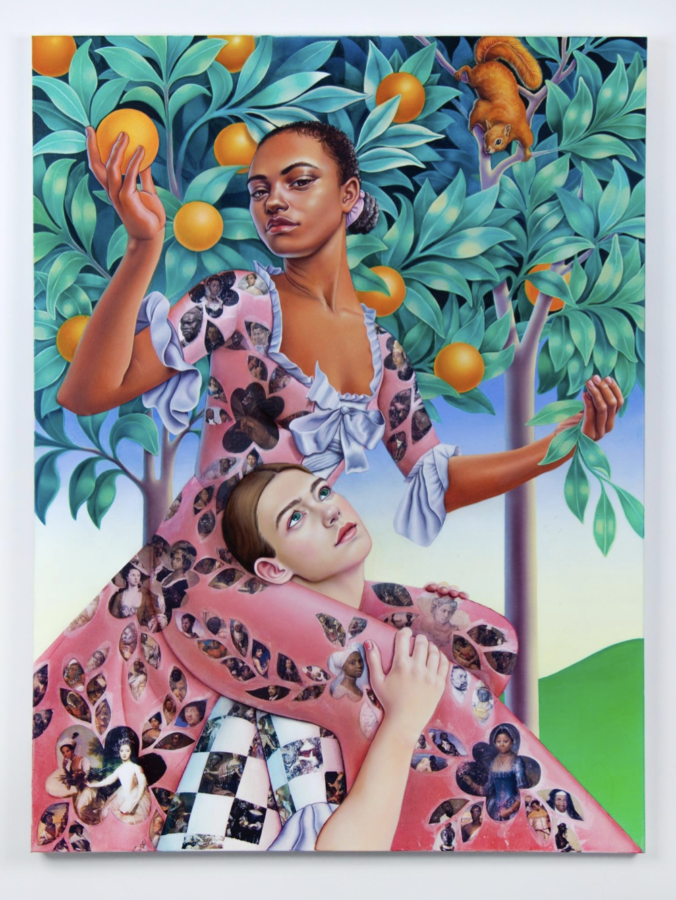Steinkraus raises environmental awareness with “Impossible Garden”
W&L began Women’s History Month with a lecture on female artists and the environment
Steinkraus’ “Picking Oranges” piece is one example of the overlap of feminist and environmentalist themes in “Impossible Garden.” Photo courtesy of www.1969gallery.com
March 13, 2023
As part of Washington and Lee Museums’ Lunch and Learn Lecture Series, artist and professor Emma Steinkraus discussed her work, influences and ongoing concern with gender and the environment on March 6.
The theme for the Lunch and Learn Lecture Series this semester is “Women in the World,” two concepts which are important to Steinkraus and her most recent exhibit, “Impossible Garden.”
“Impossible Garden” spotlights the work of women artist-naturalists from the 16th through the 19th centuries and the flora, fauna and fungi they studied, according to the W&L Museums’ website.
Love of art and love of the natural world were instilled in Steinkraus from a young age, and remain central to her work.
“I’ve always liked to draw. My dad is an entomologist so I grew up immersed in the natural world. We had an observational beehive on the mantle, and made little racetracks for cockroaches,” she said.
Steinkraus was also exposed to some more traditional, if scattered, art influences.
“As a kid I saw very little art in person. Long before I had seen much contemporary art I was steeped in the Renaissance and in kitsch, and I still haven’t gotten over either influence,” she said.
As she continued her education, first graduating from Williams College with a degree in studio arts, then earning her M.F.A. in painting and drawing from the University of Iowa, Steinkraus incorporated new models and techniques.
“After grad school, I continued to explore photo transfers and installation methods that layered paintings over wallpaper. I also began to revisit some of my earliest influences,” said Steinkraus. “I think this image sort of sums up some of the way that both environment and portraiture are present in my work, often trading spaces between the foreground and the background.”
One of her exhibited works features a wallpaper made of images from paintings of historical female artists. The images are layered on a background that Steinkraus made through digital and physical techniques.
“The point of the project is definitely not to form an accurate habitat but rather to create this kind of compendium of close looking that crosses borders of space and time,” she said.
This piece was inspired by what Steinkraus saw as gaps in the historical record.
“I started to discover work by earlier women painters that I related to intensely,” she said. “As I did more research I started to uncover a lineage for my own art and interest.”
As a student, Steinkraus said she was exposed to very little work by women artists who lived before the 20th century.
“Their work is still very underrepresented in museums and in scholarship, but of course many women did make art [during that time] and they often thrived as painters of animals and plants.”
Steinkraus explained that the work of women artists has a relationship to the natural world shaped by gender.
One of the things that stood out to Steinkraus in her research was the tendency that women artists had to empathize with and anthropomorphize the plants and animals they were painting. Through their works, these women often expressed that it was their experiences of feeling small, overlooked and maligned in society that led them to sympathize with animals.
“I’m really interested in that process of anthropomorphism, which I see not as a failure to see animals or the natural world on its own terms but as a process of comparison, in order to better see our relationships.”
The larger goal of her artwork is to draw viewers’ attention to the environment at a time when that attention may be critical.
“We’re living through what many scientists have called the sixth great extinction of life on this planet,” said Steinkraus. “My work asks us to both re-evaluate the work of marginalized women artists and to treat paintings of animals and plants as a serious artistic genre. My goal is to help us see ourselves as embedded deeply in both complex histories and environments in order to help us know and care about those better.”



